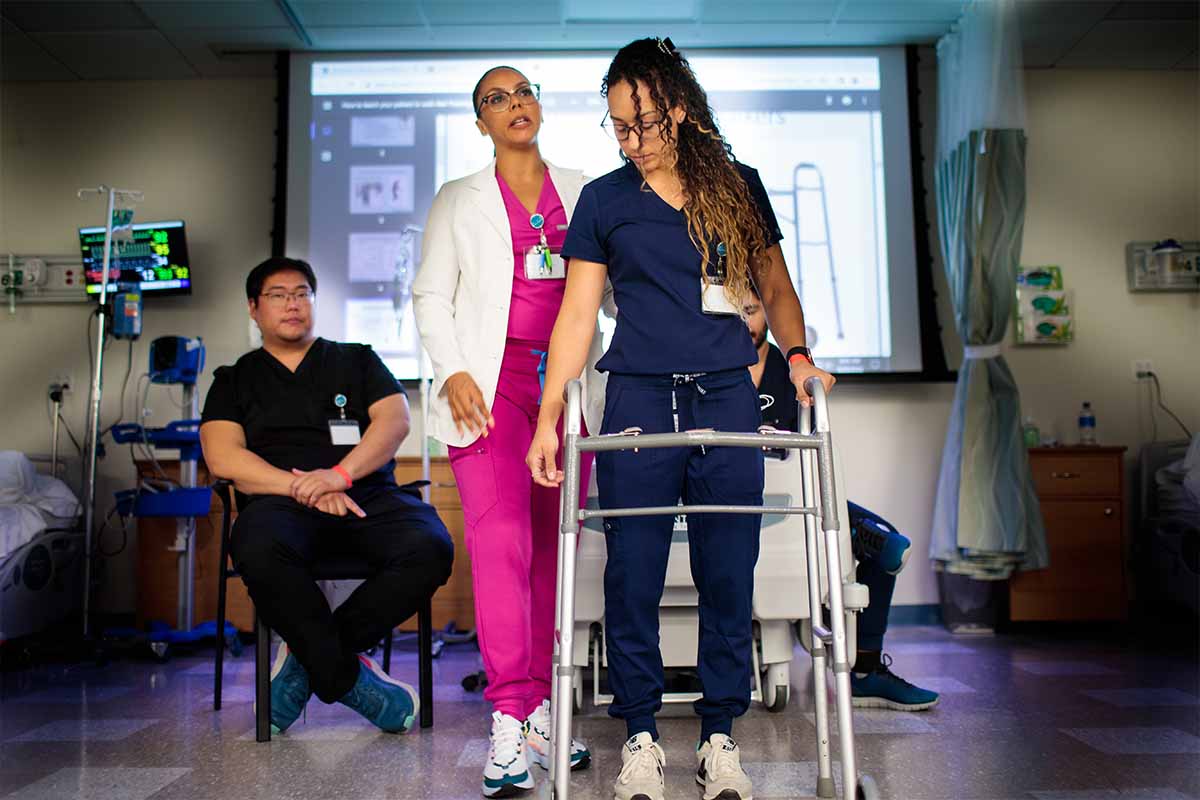

If you are seeking a rewarding health sciences role that centers on improving patients’ lives, consider a career as an occupational therapist (OT). This exciting career might be a good fit for a compassionate individual who wants to support others.
So, what does an occupational therapist do? An occupational therapist’s job description typically includes working with patients to improve their overall well-being and enhance their ability to engage in everyday activities.1
Learn the answer to “What do occupational therapists do?” along with the many opportunities this profession offers.
Table of Contents
- What Is an Occupational Therapist
- What does and OT do?
- Occupational Therapy Specialties
- Where Does an Occupational Therapist Work?
- How to Become an Occupational Therapist
- FAQ
- Prepare for a Career in OT with USAHS
What Is an Occupational Therapist?
An occupational therapist works with patients whose illnesses, injuries and disabilities impact their ability to perform basic daily living and work activities.2 OTs evaluate patients’ needs and identify goals to help them recover, maintain or improve those skills.2,3
“OTs learn about who you are and help you get back to doing the things that are important to you,” says Maureen Johnson, PhD, MS, OT/L, Associate Professor of Occupational Therapy at the University of St. Augustine for Health Sciences (USAHS).

What Does an OT DO?
Initially, an occupational therapist’s responsibilities include assessing a patient’s needs. They do not diagnose a condition.3 Typically, during the first appointment, an occupational therapist’s role will include 2:
- Reviewing the patient’s medical history
- Interviewing the patient
- Observing the patient performing specific movements or activities
Following a patient assessment, what an occupational therapist does is refocus on planning and implementing a treatment plan, which involves2:
- Selecting the best activities for the patient’s goals
- Demonstrating the exercises or daily living tasks
- Evaluating the patient’s environment for potential improvements
- Recommending adaptive equipment and showing how to use it to patients
As the patient works through the treatment plan, what an OT does is continually assess and record their progress, adjusting it as needed.2 They work collaboratively with the patient’s doctors and healthcare team and educate family members and caregivers on how to support the treatment plan.
Some occupational therapist job descriptions include overseeing occupational therapy assistants (OTAs) or aides in their healthcare setting.2
Occupational Therapy Specialties
Once you’re a practicing occupational therapist, you can earn an advanced certification in several specializations.4 These specialty certifications show your patients and potential employers that you have advanced skills, knowledge and practice experience in specific areas of care.5


The American Occupational Therapy Association (AOTA) offers different specialization board certifications, including:4


So what do occupational therapists do besides the above? Other occupational therapy specializations include:
- Aquatic Therapeutic Exercise through the Aquatic Exercise Association (AEA)6
- Assistive Technology through the Rehabilitation Engineering and Assistive Technology Society of North America (RESNA)7
- Autism through the International Board of Credentialing and Continuing Education Standards (IBCCES)8
- Brain Injuries through the Brain Injury Association of America (BIAA)9
- Clinical Anxiety Treatment through the Evergreen Certifications10
- Diabetes through the Certification Board for Diabetes Care and Education (CBDCE)11
- Hand Therapy through the Hand Therapy Certification Commission (HTCC)12
- Hippotherapy through the American Hippotherapy Certification Board (AHCB)13
- Neuro-Developmental Treatment (NDT) through the Neuro-Developmental Treatment Association (NDTA)14
- Saebo through Saebo15
- Seating and Mobility Specialty (SMS) through the Rehabilitation Engineering and Assistive Technology Society of North America (RESNA)16
- Stroke Rehabilitation through Neurorecovery Unlimited17
Where Does an Occupational Therapist Work?


While most occupational therapists work in healthcare settings, such as hospitals and rehabilitation offices, other places employ occupational therapists.
Many occupational therapists also work in schools, home healthcare services and nursing care facilities.18 Others work as virtual occupational therapists or prefer to become travel occupational therapists. Some also work as consultants in health information technology, driving and community mobility, public health and more.1
Depending on their career path, OTs can either work full- or part-time, and some occupational therapist job descriptions may require them to work nights and weekends depending on patient needs.18
How to Become an Occupational Therapist
Earning at least a master’s degree in occupational therapy and a license to practice are two common prerequisites for becoming an occupational therapist. The typical path for most occupational therapists is as follows:19
- Earn a bachelor’s degree. Many schools don’t require a specific undergraduate major as long as you meet the school’s admission requirements for their occupational therapy program. For the best chance of completing all the prerequisites while earning your undergraduate degree, consider pursuing one of the best undergraduate degrees for occupational therapy.
- Earn a Master of Occupational Therapy (MOT). When choosing an OT school, look for a program that fits your needs. For example, USAHS’ MOT program offers three formats (Residential, Hybrid Immersion* and Flex) to accommodate your lifestyle and circumstances.
- Pass the National Board for Certification in Occupational Therapy (NBCOT). All states require the NBCOT to apply for licensing.20
- Get your state license to practice. These requirements vary by state, so check with your state’s occupational therapy licensing board.21
FAQ
The following questions and answers can help you learn more about what an occupational therapist does.
What Conditions Do Occupational Therapists Treat?
What do occupational therapists do on a day-to-day basis? They treat many different conditions, such as3:
- Amputation
- Anxiety disorders
- Autism spectrum disorder
- Bone fractures and breaks
- Burns
- Cancer
- Carpal tunnel syndrome
- Cerebral palsy
- Dementia
- Depression
- Developmental delays
- Down syndrome
- Multiple sclerosis
- Osteoarthritis
- Paralysis
- Parkinson’s disease
- Prostheses
- Rheumatoid arthritis
- Schizophrenia
- Spina bifida
- Spinal cord injuries
- Stroke
- Traumatic brain injuries (TBI)
What’s the Difference Between Occupational Therapy and Physical Therapy?
Patients often wonder if they should pursue occupational therapy vs. physical therapy.
Patients participate in occupational therapy to improve their ability to perform everyday activities independently. These patients often experience cognitive or developmental disabilities or injuries that negatively impact their motor skills, behavior or emotions.
Patients attend physical therapy to improve their range of motion and manage pain after an injury. For example, someone who breaks their wrist playing a sport would need to attend physical therapy sessions to strengthen it after removing the cast.
What Is the Outlook for Occupational Therapy Careers?
Employment for occupational therapists is expected to grow 12% by 2032, with about 9,600 annual openings in the United States.23 This is a much faster growth than the average for all occupations.
Is Being an Occupational Therapist Worth It?
Becoming an occupational therapist is a promising career. OTs can enjoy an average salary significantly higher than the 2022 national average of $63,795.13.23 There’s potential for job growth, and you may choose between various settings and specialties.
Prepare for a Career in OT with USAHS
USAHS has been committed to graduate health sciences education since 1979, with five destination campuses in San Marcos, St. Augustine, Miami, Austin and Dallas.* Our MOT and Doctor of Occupational Therapy (OTD) programs focus on student success with collaborative cohorts and expert faculty-practitioners.
Learn more about multiple start dates and flexible pathways for the MOT program, or apply today to pursue your dream and become an occupational therapist.
*The entry-level occupational therapy master’s degree program at the Dallas, Texas, campus has applied for accreditation and has been granted Candidacy Status by the Accreditation Council for Occupational Therapy Education (ACOTE) of the American Occupational Therapy Association (AOTA), located at 6116 Executive Boulevard, Suite 200, North Bethesda, MD 20852-4929. ACOTE’s telephone number c/o AOTA is (301) 652-AOTA and its web address is www.acoteonline.org. The program must have a preaccreditation review, complete an on-site evaluation and be granted Accreditation Status before its graduates will be eligible to sit for the national certification examination for the occupational therapist administered by the National Board for Certification in Occupational Therapy (NBCOT). After successful completion of this exam, the individual will be an Occupational Therapist, Registered (OTR). In addition, all states require licensure in order to practice; however, state licenses are usually based on the results of the NBCOT Certification Examination. Note that a felony conviction may affect a graduate’s ability to sit for the NBCOT certification examination or attain state licensure. Students must complete 24 weeks of Level II fieldwork within 24 months following completion of the didactic portion of the program.
Sources
- “What Is Occupational Therapy?” American Occupational Therapy Association, https://www.aota.org/about/what-is-ot
- Bureau of Labor Statistics, U.S. Department of Labor “Occupational Therapists: What Occupational Therapists Do,” BLS, April 17, 2024, https://www.bls.gov/ooh/healthcare/occupational-therapists.htm#tab-2
- Cleveland Clinic, “Occupational Therapist,” Cleveland Clinic, February 27, 2024, https://my.clevelandclinic.org/health/articles/24617-occupational-therapist
- “AOTA’s Advanced Certification Program,” American Occupational Therapy Association,https://www.aota.org/career/advanced-certification-program
- “Specialty Certified Practitioners,” American Occupational Therapy Association, https://www.aota.org/career/advanced-certification-program/specialty-certified-practitioners
- “Certify,” Aquatic Exercise Association, https://aeawave.org/Certify
- “ATP Exam Eligibility Requirements,” Rehabilitation Engineering and Assistive Technology Society of North America, https://www.resna.org/Certification/Assistive-Technology-Professional-ATP/ATP-Exam-Eligibility
- “Improve Your Reach & Outcomes as a Certified Autism Specialist,” International Board of Credentialing and Continuing Education Standards, https://ibcces.org/certified-autism-specialist/
- “Certified Brain Injury Specialist,” Brain Injury Association of America, https://www.biausa.org/professionals/academy-of-certified-brain-injury-specialists/certified-brain-injury-specialist/cbis-information-eligibility
- “Certified Clinical Anxiety Treatment Professional,” Evergreen Certifications, https://www.evergreencertifications.com/certification/certified-clinical-anxiety-treatment-professional/
- “Thinking about Earning the CDCES?”, Certification Board for Diabetes Care and Education, https://www.cbdce.org
- “Eligibility Requirements,” Hand Therapy Certification Commission, https://www.htcc.org/certification/examination-information/eligibility-requirements
- “What is Hippotherapy?”, Hippotherapy Certification Board, https://hippotherapycertification.org/
- “Neuro-Developmental Treatment Association,” Neuro-Developmental Treatment Association, https://www.ndta.org/
- “Saebo Certification – Live,” Saebo, https://www.saebo.com/pages/saebo-certification-live/
- “SMS General Info,” Rehabilitation Engineering and Assistive Technology Society of North America, https://www.resna.org/Certification/Seating-and-Mobility-Specialist-SMS
- “Certified Stroke Rehabilitation Specialist (CSRSTM), Neurorecovery Unlimited, https://strokecertification.com/seminars/csrs
- Bureau of Labor Statistics, U.S. Department of Labor, “Occupational Therapists: Work Environment,” BLS, April 17, 2024, https://www.bls.gov/ooh/healthcare/occupational-therapists.htm#tab-3
- Bureau of Labor Statistics, U.S. Department of Labor, “Occupational Therapists: How to Become an Occupational Therapist,” BLS, April 17, 2024, https://www.bls.gov/ooh/healthcare/occupational-therapists.htm#tab-4
- “NBCOT” National Board for Certification in Occupational Therapy, https://www.nbcot.org
- “Licensure,” American Occupational Therapy Association, https://www.aota.org/career/state-licensure
- Bureau of Labor Statistics, U.S. Department of Labor, “Occupational Therapists: Job Outlook,” BLS, April 17, 2024, https://www.bls.gov/ooh/healthcare/occupational-therapists.htm#tab-6
- “National Average Wage Index,” Social Security Administration, https://www.ssa.gov/oact/cola/AWI.html







